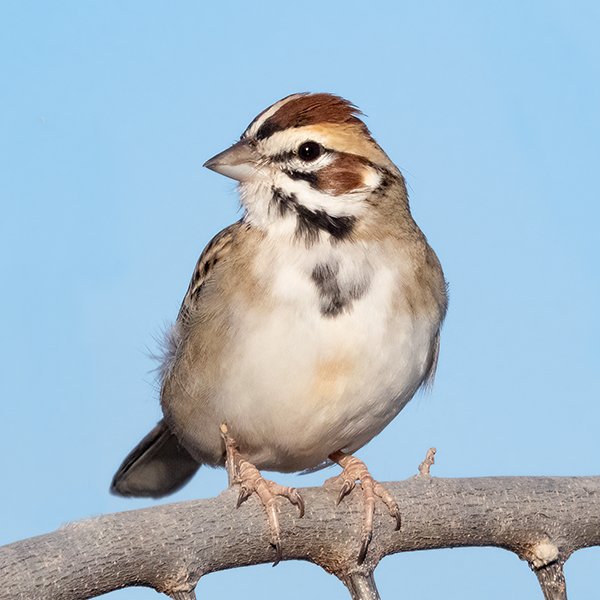Bird of the Month: Lark Sparrow
Written by Andy McCormick
Andy McCormick, Volunteer and Former Board President of Eastside Audubon
The Lark Sparrow is our largest open country sparrow. Its intricate facial pattern is a spark of brightness in the grasslands.
The harlequin-faced Lark Sparrow is one of North America’s most attractive sparrows. White head stipes outlined in black alternate with the chestnut eye stripe and cheek patch. A central breast spot is the only mark on the otherwise clear white breast and belly. These field marks combined with large white corners on the tail make the Lark Sparrow unique among sparrows. Lark Sparrows inhabit open short grass meadows where they are often found foraging on the ground or perched on scattered shrubs and trees. In farmland they will also perch on fences and wires. Photos, videos, and vocalizations of the Lark Sparrow can be viewed at the Macaulay Library.
The Lark Sparrow has its own genus Chrondestes, which from the Greek khondros, for grain and edestes, eater, emphasizes its diet of grass and weed seeds. The specific epithet, grammacus, for a line in a drawing, references the black line through the eye (Holloway). The Lark Sparrow will sing during flights that are higher than those of other sparrows, possibly reminding the European ornithologists, who gave it an English name, of the Skylark (Dunne).
GRASSLAND SPECIALIST
The Lark Sparrows prefers a mixed habitat of grass and bare ground and can do well in disturbed areas. For example, the species population will increase for a few years after a fire, especially if shrubs or sagebrush are not completely burned. However, as vegetation growth and ground litter build up, this sparrow may move on to a new location (Martin and Parrish). In addition to seeds and waste grain, the Lark Sparrow will also consume insects such as grasshoppers, beetles, and caterpillars during the summer nesting season (Aversa, et al).
Both sexes participate in nest building. The male seems to suggest nesting sites by dropping twigs in a few locations, but the female chooses the final place in which to build an open cup nest made of grasses and twigs. Usually, four to five eggs are deposited in the nest which is lined with fine grass and animal hair. The female incubates the eggs for about two weeks and the young will be ready to leave the nest in less than two more weeks (Kaufman).
Lark Sparrow
Scientific Name: Chondestes grammacus
Length: 6.5”
Wingspan: 11”
Weight: 1 oz (29 g)
AOU Alpha Code: LASP
STATUS AND DISTRIBUTION
Data on the Lark Sparrow in Washington are lacking. However, studies in Oregon indicate that these sparrows arrive in that state’s shrub-steppe habitat from late April to May. Breeding continues through July, and they begin migrating from the nesting area by mid-August (Martin and Parrish).
Overall, the Lark Sparrow is widespread and common in the central and western parts of the United States, southern Saskatchewan and Manitoba, and in central Mexico. Over the past half century, the eastern portion Lark Sparrow’s range has contracted toward the west as previously cleared land is claimed by reforestation or expansion of human development. The current range may represent the bird’s Pre-Columbian range when eastern forests covered the land.
The Lark Sparrow winters in small areas of Oregon and Idaho, in most of Western California, and in north-central Mexico. Its population is stable and there are no management programs in place. However, studies of shrub-steppe and sagebrush habitat birds often include data on the Lark Sparrow.
Photo credit: Mick Thompson
References available upon request from amccormick@eastsideaudubon.org
Visit the Eastside Audubon Bird Gallery to read Bird of the Month articles covering over 200 bird species.



